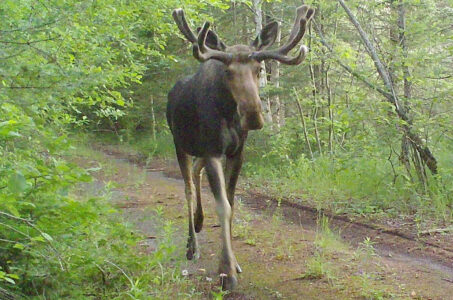May to usher in a new wave of visitors
- A male yellow-rumped warbler watches for insects after coming back to the region. Betsy Bloom/Daily News photos
- The yellow-rumped warbler is striking, with black and white markings, along with bright yellow patches.
- The Wilson’s snipe is larger than a woodcock and has a longer bill.

A male yellow-rumped warbler watches for insects after coming back to the region. Betsy Bloom/Daily News photos
As May arrives, so, too, should a new wave of migrating birds.
While most of the waterfowl should have pushed through — Six Mile Lake had several varieties, including the first blue-winged teal I’ve photographed (though I’m sure they’ve visited the lake in the past, being a common species) — the first reports and photos of neotropicals species are coming in from southern Wisconsin and Michigan.
These are songbirds that usually spend the winter in Central and even South America, so take some time to get back, especially if conditions don’t cooperate, as happened through much of late April. Like other birds of the lush tropical forests, the males often sport vivid plumage colors and patterns — rose-breasted grosbeaks, orioles, tanagers, hummingbirds.
So the next week or so might be time to get the grape jelly, orange halves and nectar ready for the feeders.
Last Sunday saw some of the first warblers. The yellow-rumped is common to the region and among the earliest to come back north and latest to depart in the fall. The eastern subspecies, which used to be classified separately as the “myrtle” warbler, is striking with black and white markings on the male and bright yellow patches on the crown, where the wings join the chest and, of course, at the base of the tail, leading to the nickname “butterbutt.” The female, not surprisingly, has more subtle but still attractive coloring.

The yellow-rumped warbler is striking, with black and white markings, along with bright yellow patches.
They are among the largest and perhaps the most numerous of the warblers in the region, preferring coniferous trees to deciduous woodlands, according to the Cornell Lab of Ornithology’s All About Birds website, https://www.allaboutbirds.org. They nest in hemlock, spruce, white cedar, pine, Douglas fir, larch or tamarack. Their ability to digest wax in berries as a food source allow them to winter farther north than other warblers, which can explain why they appear back north sooner than most warblers, according to the Cornell Lab. They will feed on seeds as well, also unusual among warblers.
As with other birds in spring, now is the time to see them in their best breeding plumage; the lack of foliage makes them easier to spot as well.
Look for them in quick-moving flocks foraging among the branches and tops of trees and shrubs. Photographing them is a challenge, because they don’t sit still for long.
*****
Another note about bird feeders — a Felch Township resident said a bear took down the ones at her home late this week. So whatever you’re putting out during the day, probably best to bring it in overnight, especially out in the more rural areas.

The Wilson’s snipe is larger than a woodcock and has a longer bill.
*****
One other effect of last week’s late snow was to ground a number of migrating birds. Much the same as with aircraft, icing can be a problem for birds flying through a storm system. Six Mile Lake had a number that looked like they took a break from attempting to fight on through.
The snow that lingered through much of Monday and into Tuesday, at least by us, also drove a number of ground-foraging birds to the roads, where the pavement and bare roadsides had warmed enough to not become covered in a blanket of white.
This, too, can offer an opportunity to see birds that might otherwise be fairly hidden, though most of what I observed Monday were robins, apparently not wanting to wade through the heavy, wet snow.
But keeping an eye out turned up a Wilson’s snipe, a normally secretive shorebird that looks a lot like a woodcock at first glance but is larger and has a longer bill. Like the woodcock, it uses that bill to probe deep for insects, crustaceans and worms, according to All About Birds, though it prefers the wet soils of marshy habitats.
They do nest both in Wisconsin and Michigan, though both states are at the southern side of its breeding range, which can reach the arctic to the north, the Cornell Lab stated. I was told online they are a common game bird in Michigan.
This one may have been simply making a stop as the snow moved through, or perhaps was a regular resident normally unseen among the cattails and grasses.
One more serious result of the weather system that moved through earlier this week — Paul A. Smith of the Milwaukee Journal-Sentinel reported Wednesday that common loons became so iced up trying to navigate through the storm in northeastern Wisconsin that dozens dropped from the sky, leading to about 35 phone calls about stranded loons to the Raptor Education Group Inc. in Antigo, Wis.
Loons have feet positioned far back — an adaption that helps with swimming and diving but prevents true walking. If the bird comes down on the ground, it can’t take off again, nor can it hike to a water source unless very close by, Smith explained. Even then, if the pool’s too small, it won’t have enough room as a runway to gain enough speed for flight, according to the article. One loon had to be captured on someone’s pond.
Some grebes can have the same issues when they wind up on the ground. It makes you worry about the ones that went unseen.
Betsy Bloom can be reached at 906-774-2772, ext. 240, or bbloom@ironmountaindailynews.com.







